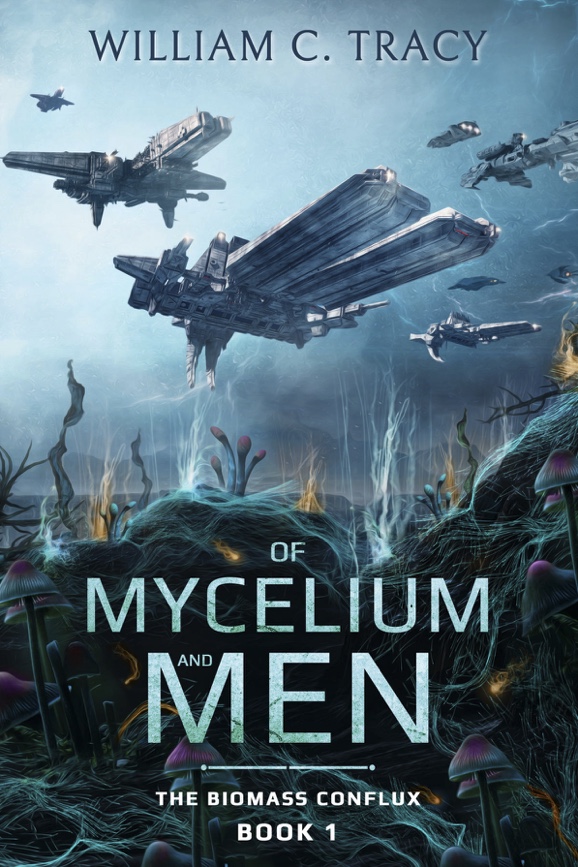Genre: Sci-Fi, Colonization, First Contact
LGBTQ+ Category: Ace, Bi, Demi, Gay, Non-Binary, Poly, Trans MTF
Get It On Amazon | Publisher
About The Book
Lida was their last chance for an uncolonized planet. But a world-spanning fungus had colonized it first.
Agetha and her husband have spent their whole lives in the fleet’s zero-G. Now all is turmoil as the fleet lands, discovering they are surrounded by a single fungal biomass spanning the entire planet. To build a new home, the fleet must confront a dangerous organism, and Agetha must decide if she can raise a family in this inhospitable landscape.
Jane Brighton holds tenuous command over the colony and its administrators. She and the other gene-modded leaders emerged from their four-hundred-year suspended animation to find a crew much different from the one that departed Old Earth. Jane must direct the colony’s fragile growth and defend it against being overrun by the fast-growing biomass.
But there is something none of the colonists know. The massive organism that spans the planet is not simply a fungal mass, nor even a chimerical combination of species that once roamed the planet. The biomass has desires and goals, and one is to know these strange beings carving out a home in its midst.
The Review
Well, damn.
That’s my reaction when I finally put down the book I found myself glued to all of this last week.
Of Mycelium and Men is colonization sci-fi. The subgenre is one of my favorite jams, and all the better because William C. Tracy just does it so fricking well.
The story starts aboard a fleet of generation ships from Earth. The mission was supposed to find a habitable planet on its first two or three stops, but after a string of failures, they’re now arriving at target system 11 after more than four hundred years in space. A whole new society of “generationals” has evolved during the journey – a caste based system where children are locked into the vocations of their parents. The generationals are the grunts of the fleet, and are all a bit taller (and their eyes bigger) than Earth-born humans.
But Earth hasn’t been entirely left behind. There are also the vagals – super soldiers who have been enhanced by an implant along the vagal nerve that helps them perceive and react more quickly to danger. And the Admins, eight Earth-born humans, kept in sus-ani (suspended animation) most of the time, thawed out only when important decisions need to be made.
This split society, and the drift that has occurred over four centuries, It sets up a neat triangle for future conflict within the colonists themselves. More on that later.
System 11 has one potentially habitable planet, which is entirely covered in fungus – hence the mycelium in the title. One of the Admins is thawed, and makes the decision to try to build a colony on the world, which soon comes to be called Lida.
Only after the ships land, using their engines to clear a blast zone for the colony, do the new arrivals start to learn what they are up against – a world-spanning organism hell-bent on ridding its world of the colony.
The story features a large cast, something near and dear to my heart, from the generationals running the ships through the vagals fighting to keep the “biomass” out of the colony, to the Admins who will outlive them all and are working to lock down their control of this new world. There’s a slow creep toward authoritarianism that’s uncomfortably close to where we find ourselves now.
Tracy also gives us tantalizing glimpses of the truly alien mindset of the world-spanning biomass, as it tries to figure out these strange new arrivals from another star.
This is a truly epic tale, spanning the first twenty years of the colony. There are so many setbacks that the original schedule to complete Lida’s first city is thrown off by more than a decade, as the new columnists have to deal with the constant (and often deadly) incursions by the biomass.
Tracy drops in some bombshells at regular intervals, interspersing the achingly slow progress of the colonists as they deal with their new world with sporadic, violent attacks by agents of the biomass as it tries new tactics to breach their defenses. It’s a war of attrition the colonists are slowly losing as their supplies dwindle.
The story this most immediately reminded me of was Deathworld – a book by Harry Harrison where a society of super men is engaged in a death struggle with the plants of the planet, which have laid siege to their city. It’s been a long time since I read it, but from what I recall about it, Tracy’s book is much more nuanced. Still, the fascinating idea of man vs. plant (or in this case, fungus) is similar.
It also recalled SI CLARKE’s Livid skies, a Mars colonization book which has much the same great advance/setback dynamic going on – although the Martians don’t have to deal with a deadly fungus seemingly intent on their annihilation.
I was totally absorbed in this tale and started nervously glancing at the “percent read” indicator on my Kindle as I passed 90%. It dawned on me that I wasn’t going to get the exciting finale I craved, at least not in this book. A Facebook message to the author confirmed it. This is the first book in a trilogy, and many questions are left to be answered in the next two.
That’s my one complaint about it. It ended far too soon. Seriously, this book is so good, I found myself making excuses to read it even when I should have been doing something else.
So yeah, I may have to wait a bit for the next installment. But even so, it was worth it to spend a few hours immersed in Tracy’s world. I don’t usually issue star ratings, but if I did, this one would be a 5.5.
The Reviewer
Scott is the founder of Queer Sci Fi, and a fantasy and sci fi writer in his own right, with more than 30 published short stories, novellas and novels to his credit, including two trilogies.

